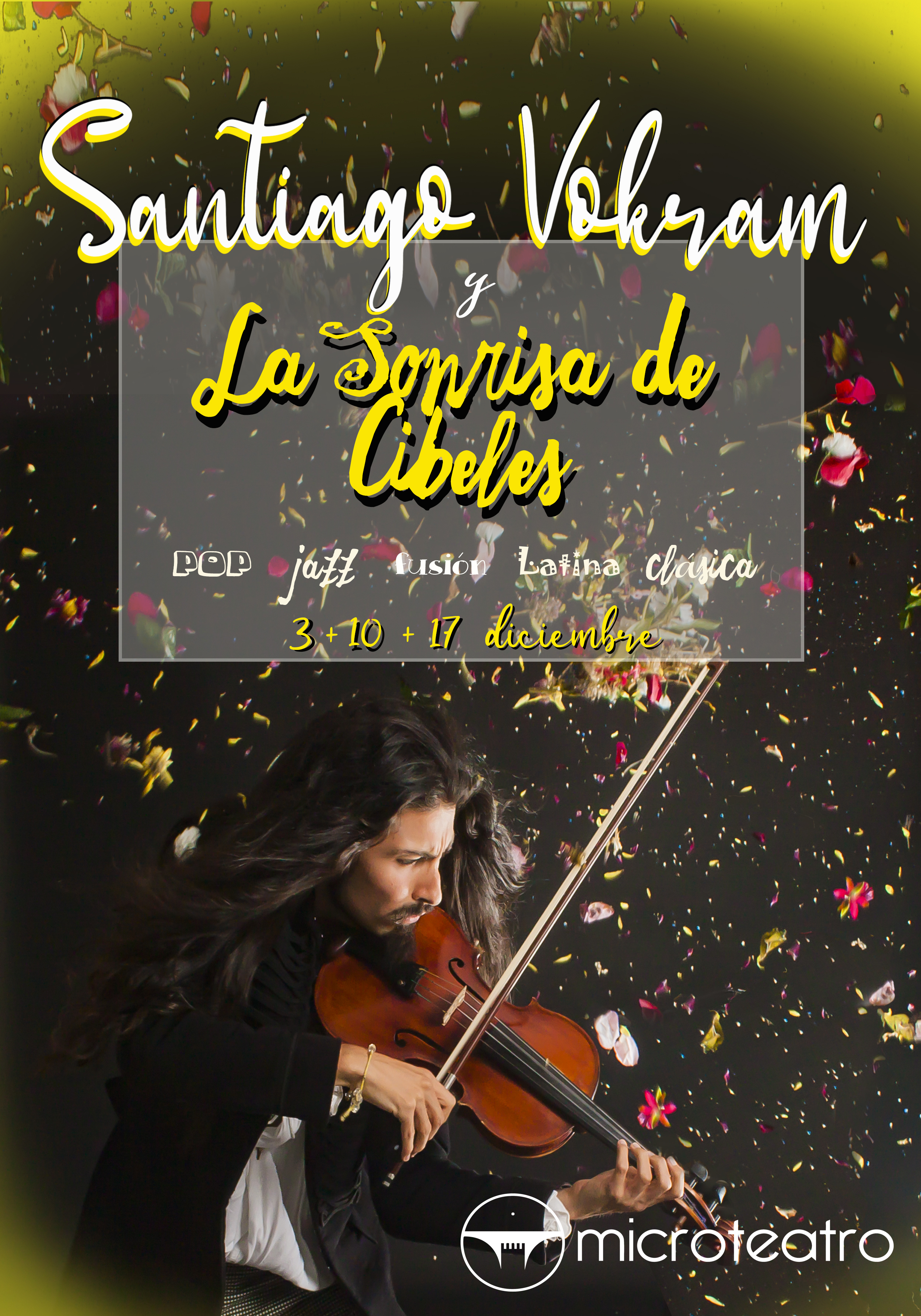Whether it’s your first time in the city or you’ve been living here for years, this guide provides a little something for everyone. You’ll find a mix of touristy and non-touristy things to do in Madrid, along with hidden gems and quirky tidbits scattered throughout.
We plan on updating this guide regularly with our own discoveries and friendly suggestions. So feel free to comment!
Wining & dining
As you walk through the streets of Madrid it can feel like there are more bars and restaurants than people. Choosing where to eat and drink among all the options is tricky at times, so here’s a list to start off with:
Food markets
Many of Madrid’s neighborhood markets have been revamped while preserving their traditional spirit. They’re one of the best ways to experience Madrid’s food culture. Here’s a list of the most popular mercados:
Mercado de San Miguel: The city’s prettiest and most famous food market, situated right off Plaza Mayor. The quality here is excellent, although you’ll usually find hordes of visitors.
Mercado de San Fernando: My favorite food market in the city, situated in Lavapiés. Here you’ll find a great, casual atmosphere, visited by locals and foreigners alike. There’s a wonderful mix of food stalls, from the Asturian El Guaje de Lavapiés to the Portuguese Mercadillo Lisboa.

Mercado de San Antón: If you’re in Chueca and not sure where to go, head over to this multi-level food market and grab a drink on the rooftop bar, open year round!
Mercado de Antón Martín: This popular market offers several classic food stalls and international eateries, including one of the city’s best Italian restaurants, Fiaschetteria La Saletta.
- Tip: just one flight up you’ll find the most important flamenco dance studio in Madrid, Amor de Dios! Pop up to feel the vibe.
Mercado de la Cebada: Located in La Latina, this market especially comes alive on Saturdays. You’ll find visitors eating and drinking amid the labyrinth of stalls. Join them!


Mercado de Vallehermoso: Located near Arguelles, this one’s a little less central than the others, but no less active. You’ll find the traditional market stalls situated alongside modern options like the popular Kitchen 154, specializing in spicy Asian street food dishes.
Restaurants, bars and cafés:
Bodegas Rosell: If you’re looking for an authentic Spanish meal, it’s best to go to one of the old-school tabernas that have stood the test of time, like Bodegas Rosell, situated by Atocha.

Three more Spanish eateries we love:
- Juana la Loca: A family-run Spanish restaurant in La Latina offering a wonderful ambience and a menu featuring traditional and international dishes, and pintxos with a creative twist. Always a great choice.
- Casa Mingo: A one-of-a-kind and very no-frills restaurant specializing in roasted chicken and sidra (cider) – so you get to learn how to pour it in the Asturian way (escanciar).
- Bar Lambuzo: One of the first restaurants we ever wrote about on Naked Madrid, back in 2014. Lovingly run by a family from Cádiz, this welcoming taberna serves authentic dishes from Andalucía. Bar Lambuzo now has three locations: Sol, Mercado de Chamberí, and Retiro.

Typical tapas at Bar Lambuzo
Tapas bar hopping in La Latina: At least one night in Madrid should be dedicated to tapas bar hopping, and one of the best streets to do this on is Cava Baja, along with its surrounding calles and plazas. Here you’ll find bar after bar… after bar.
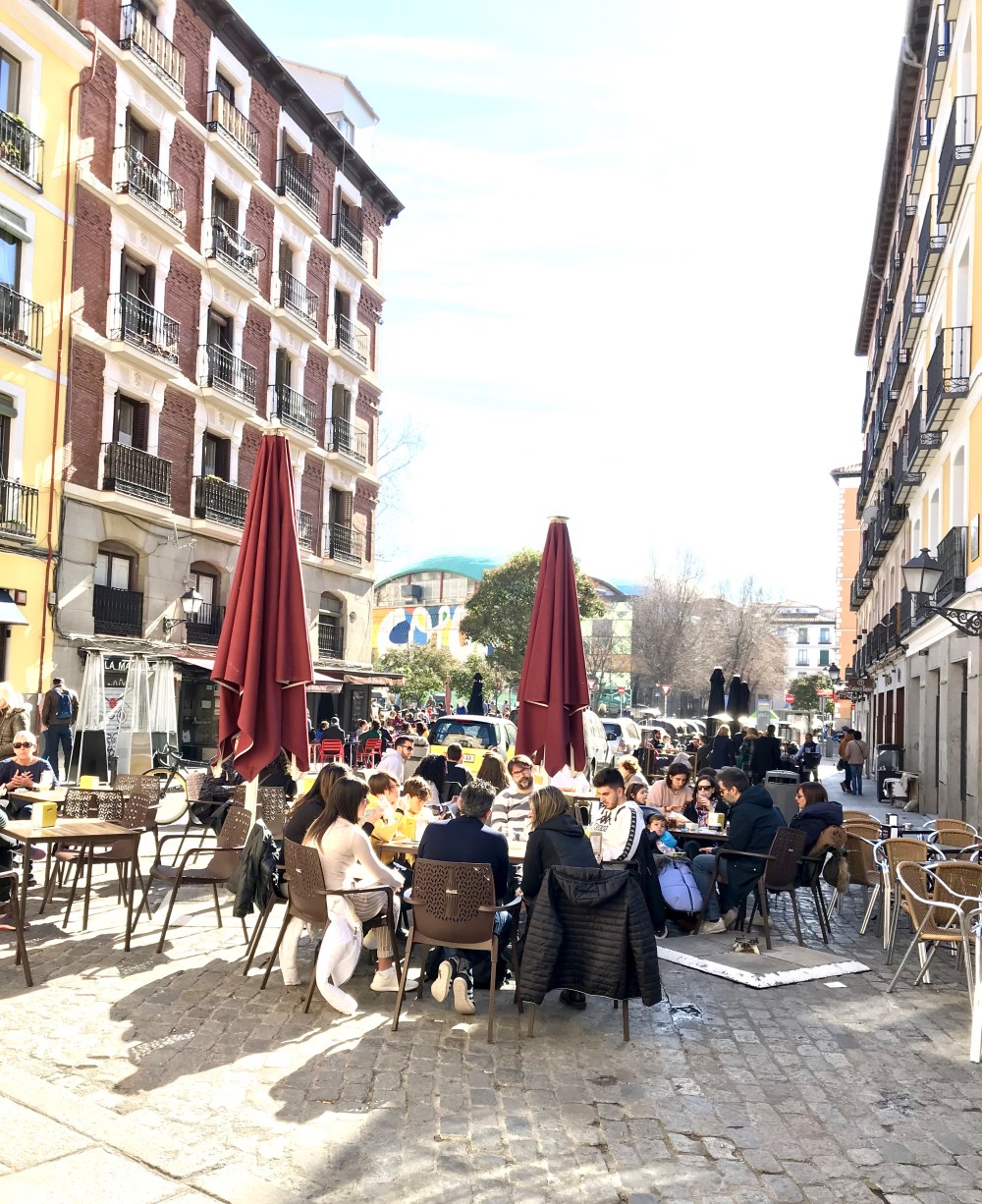
Calle Ponzano, the city’s top foodie street. Madrid has chosen Calle Ponzano to become its gourmet golden mile, lined with great restaurants to choose from, including Sala Despiecie, Alipio Ramos and Toque de Sal.
Corredera Bajo de San Pablo in Malasaña. This is another street that’s full of fun bars and restaurants, including Amargo Place to Be (with live music), Elemental Bistro (French-Spanish cuisine) and Aió (Sardinian restaurant with a bike storage downstairs). There’s also the famous Teatro Lara, and…
- Secret bar at Kikekeller: This design studio turns into a clandestine bar at night on the weekends, when art and mixology come together.
Lavapiés has it all: Malasaña and Chueca have become so popular that it’s a bit overwhelming at times. The multicultural neighborhood of Lavapiés offers a more casual vibe, yet there’s no shortage of food options.
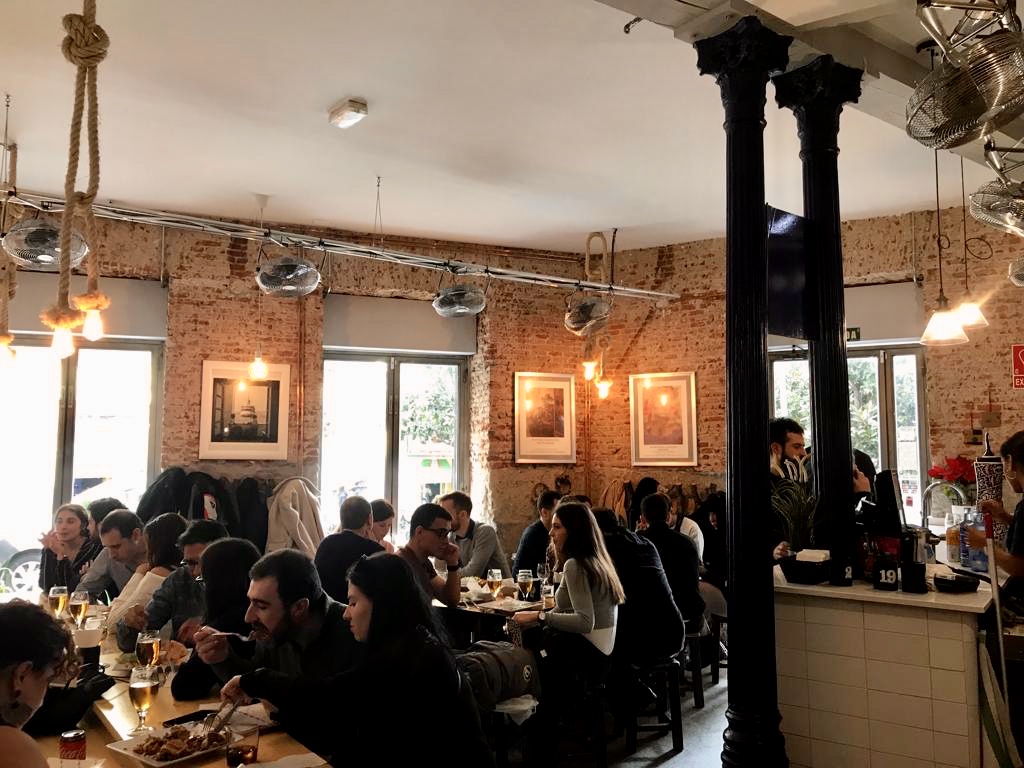
Egeo, a popular Greek place in Lavapiés
Barrio Slamanca: This is the city’s higher-end area. It’s very pretty and has some of the best eateries in the city, from Michelin-starred restaurants to friendly neighborhood bars. We’d love to explore Salamanca’s hidden gems more. Here are some of the places we’ve previously featured:
- StreetXO, a casual version of the world-famous DiverXO by rockstar chef Dabiz Muñoz
- Arugula, a restaurant by Retiro Park serving great salads and healthy dishes
- Tandoori Station, one of the city’s top Indian restaurants
- Banibanoo, a wonderful market-style Iranian restaurant
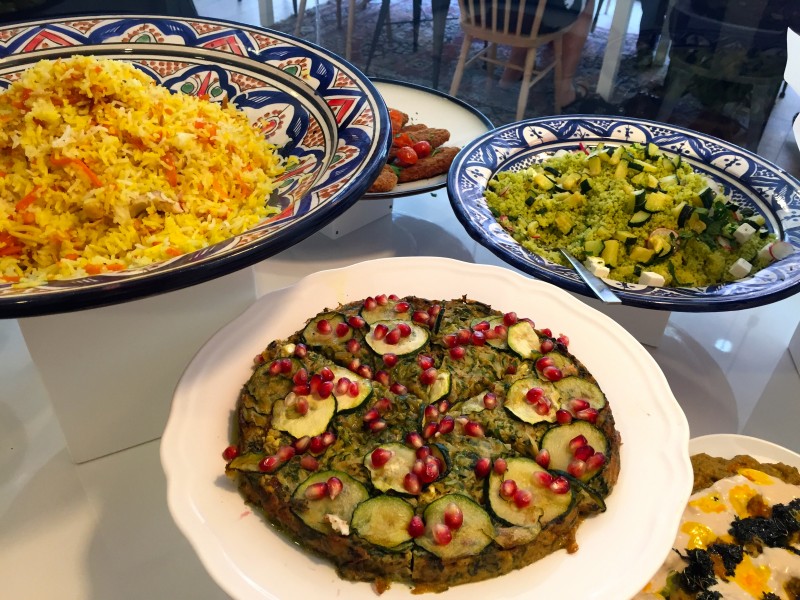
Delicious and seasonal Iranian dishes at Banibanoo
Go on a hunt for the best tortilla: This Spanish comfort food always hits the spot and you can order a “pincho” (slice) at just about every bar in the city. Try these spots (and many others) and see which one you like best: Where to find the best tortilla in Madrid.
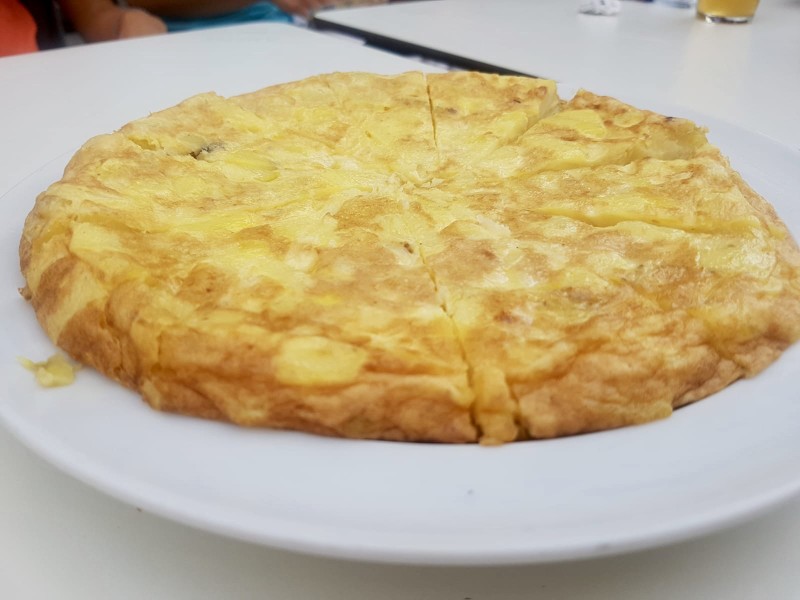
Sip on sherry at La Venencia: Please don’t leave the city without visiting this truly unique bar in Barrio de las Letras. Entering La Venencia means traveling to another time period. They only offer sherry (four types).
La hora del vermut: The city is reviving an old ritual, which entails drinking vermouth along with an aperitivo before lunchtime, especially on Sundays. Experience this tradition at these timeless bars, or at the newer vermuterías to join in on the vermouth craze.

Pic by La Vermutería, a popup bar throwing great vermouth-inspired events
Cocktails at The Cock: Madrid has some great cocktail bars. If you’re looking for the kind that hasn’t changed in… forever, then The Cock’s your safest bet. Right down the street is Del Diego, another good option.
Pepe Botella: If you’re looking for a place to get a coffee or a glass of wine in Malasaña, I personally recommend this bar in Plaza Dos de Mayo. Grab the window seat if you can. After a couple of rounds, you’ll be in the perfect state of mind to explore the neighborhood.
Also see: Work-friendly cafés in Malasaña with great Wi-Fi

María Pandora: Have champagne at this funky arts bar in La Latina. You’ll also get to watch the sunset over Parque de las Vistillas. The hours are a little odd so check online if they’re open.
Also see: Discover Madrid’s passionate poetry scene

Have a sweet treat at an old-world pastry shop: The city’s most famous is La Mallorquina, located right in Sol. You’ll usually find a line out the door for take-away, but there’s a spacious tea room upstairs.
Cultural activities
El Matadero: This former slaughterhouse is now one of the city’s most active cultural hubs, complete with a cinema, theater, café, an outdoor area used for markets and more!
Conde Duque: An enormous cultural center holding free exhibits including large-scale art projects and exhibits. It also hosts concerts, performances, book archives and even outdoor cinema which runs during summer.
- Plaza de Guardia de Corps: it’s located in a cute little plaza, surrounded by bars, restaurants and shops.
Cine Doré/La Filmoteca: A funky old cinema screening classic films from around the world in original version and at an unbeatable price of €2.50. It’s one of the city’s most popular movie houses, located right by Mercado de Antón Martín.

Sala Equis: One of the city’s trendiest hotspots, a former XXX theater transformed into an eatery and cinema, located in Tirso de Molina.
Desperate Literature: An international bookstore selling the best selection of English-language books in the city. They also throw great events, from readings to concerts.

Microteatro por Dinero: “Micro-theater” performances are all the rage in Madrid, and one of the best places to see these 15-minute shows are at Microteatro por Dinero in Malasaña. Get your €4 ticket, grab a drink and enjoy the show! It makes for a really fun night, although you do need a good level of Spanish to appreciate it.
- If you’re looking for theater in English, check out the interactive shows put on by Mad Improv. Lots of fun!
Mercado de Motores: The city’s trendiest monthly market, held in a train museum. You’ll find a variety of stalls set up along the tracks, and food trucks outside. Get there early before the crowds swarm in.
Check out Madridnofrills.com: This website offers incredibly insightful information on a side of Madrid that tourists (and locals) almost never experience, from the city’s anti-mainstream music scene to a photo series of 100 of Madrid’s no-frills bars (that’s recently gone viral!). Do have a look.
Museums
Madrid boasts several world-renowned arts institutions as well as lesser-known museums and “casa museos” (former private mansions). Here are some top picks, although you can also check out our guide to the city’s museums (and how to get in for free) here.
The Golden Triangle of Art: Madrid’s three world-famous museums are located on Paseo del Prado, and need no introduction:

Within walking distance are three other museums I’d highly recommend:
- Museo Naval: Located beside the Prado is the Maritime Museum, which houses an impressive collection that’s a surprise to many, even Madrileños.
- La Casa Encendida: Situated near Reína Sofía, this dynamic cultural center holds contemporary art exhibits and activities, both inside as well as on its rooftop terrace. Free entrance.
- CaixaForum: Also located on Paseo del Prado is a contemporary arts center with great exhibits and an urban garden wall.

Three “Casa Museos” that are incredibly charming and take you back in time:
- Museo de Cerralbo: My personal favorite. This small museum is a portal to another era. It was a former private mansion and is located next to the stunning Templo de Debod (more on that below).
- Sorolla Museum: The former house of famous Spanish painter Joaquín Sorolla. Step inside his private living quarters to see his studio and personal collection. It’s well worth a visit.
- Museo del Romanticismo: Walk through the beautiful rooms of this museum in Chueca that have been kept in tact from the Romanticism Era. Make sure to have a tea in the lovely garden afterwards.

La Neomudéjar: This is the most avant-garde museum on the list, occupying a former industrial railway building near Atocha train station.

Art shows and festivals: Madrid has a thriving arts scene, with events held year round, such as the world-famous Madrid Art Week that’s going on right now. Time Out Madrid is the best place to find out about the city’s events in English.
Plazas & streets
After seeing the mandatory Plaza Mayor and Puerta del Sol, here are a few other must-see places:
Plaza de la Villa, the city’s original town hall is absolutely beautiful, especially at nighttime. The little surrounding streets, like Calle del Codo, are also charming.
- Tip: just a few steps away from the plaza lies a sweet shop run by nuns: El Jardín del Convento, on Calle del Cordón 1.

Plaza de Oriente: Here you’ll see the Royal Palace, Royal Opera House, the Sabatini gardens and the Almudena Cathedral. There’s also a lesser-known crypt below the cathedral that boasts hundreds of columns, each one unique.
Plaza de Dos de Mayo: This happening plaza is nestled between the streets of Malasaña, one of Madrid’s trendiest neighborhood. My favorite café in this plaza is Pepe Botella (mentioned above).
Plaza Olavide: A charming plaza in Chamberí, loved by locals. Come here to sit out on a terrace and soak up the sun.
Plaza de la Paja: A very popular plaza in La Latina, full of bars and restaurants. When the weather’s nice you’ll find spacious terrazas set up everywhere – you’ll have to be quick to find a table!
Staircase streets of La Latina
La Latina is one of the city’s oldest and most beautiful neighborhoods. Take a stroll through the area’s windy, narrow streets. You’ll find several streets that have stairs, like Calle del Rollo and Travesía del Nuncio (pictured below). Just wander around a little.

This unbeatable terrace belongs to Café Angélica, a sweet café and restaurant
Streets of Lavapiés: Explore this vibrant, multicultural neighborhood. You’ll find a lot of street art on Calle Embajadores, Miguel de Servet, and Doctor Fourquet (where you’ll also find many micro-galleries).

Calle Embajadores, pic by @jessiesusanna

Calle Miguel de Servet, lined with street art, restaurants and cherry blossom trees in full bloom
Parks
Retiro: The city’s most popular park, situated in the center. There are several spots worth visiting, such as the lake, the rose garden and of course, the stunning glass palace.

Glass Palace at Retiro Park, pic by @os_car_a
Templo de Debod: Madrid houses a beautiful Egyptian temple surrounded by greenery. Come here to watch the sunset! Then take a walk through Parque del Oeste (next point).
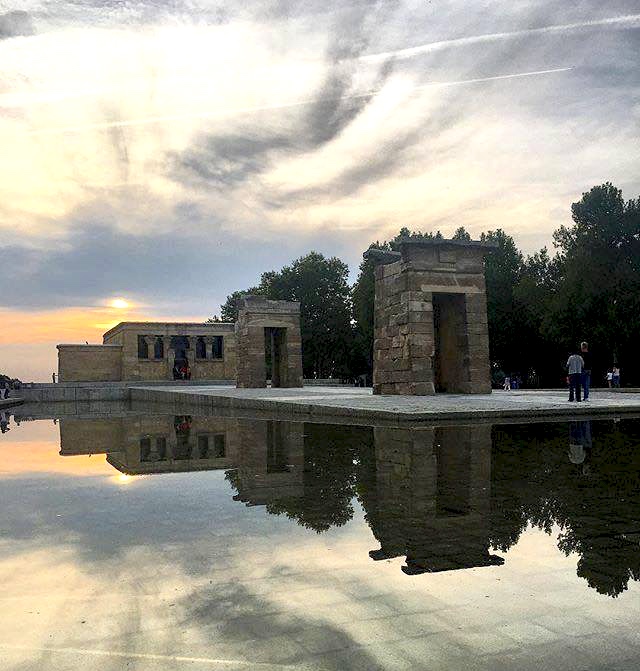
Sunset at Templo de Debod, pic by @meagamind
Parque del Oeste. This spacious park is located in the western part of Madrid, near Moncloa and Templo de Debod. It provides a much-needed breath of fresh air, plus there are outdoor concerts held during the warmer months of the year.
- Rose garden: There’s a beautiful rose garden you shouldn’t miss in spring, Rosaleda de Madrid.

Parque del Oeste, pic by @os_car_a
Casa de Campo: The largest park in Madrid. It really makes you feel like you’ve left the city. You’ll find lots of hills, trails, bike paths, bars with outdoor terraces and a lake. It’s also connected to Parque del Oeste and Madrid Río (mentioned below). You can rent a bike for the day and explore the park on wheels. Here you’ll also find:
Madrid Río Park: Madrid’s Manzanares river has been turned into a public recreation space for children and adults alike. You’ll see people having picnics, rollerblading, running, cycling, playing sports and having a drink on the terraces. Madrid Río has sprinklers open during summer, playgrounds year round and the famous “spiral” bridge.
- I like going to El Matadero first, and then taking a walk along Madrid Río afterwards, as they’re connected.
- At the other end of Madrid Río is Casa de Campo, so you can bike through both on the same route.

Rooftops
One of the best things to do in Madrid is enjoy its rooftop craze. The city has tons of azoteas, and many are open year round:
Azotea del Círculo de Bellas Artes: Pretty much all the city’s best postcards feature views from this famous rooftop. Whether you’re in the mood to stay awhile and have a drink, or just pop up to take in the view, make sure to include it on your list.

View from Círculo de Bellas Artes, pic by @os_car_a
CentroCentro Cibeles: This is the city’s most famous building, hands down. It used to be a public post office but is now a free-entrance arts and cultural center. There’s also a rooftop bar where you can see panoramic views of the city, as well as a lookout point at the very top.

Low-key rooftop bars: If you’re in the mood for a casual rooftop setting, one of our favorites is The Hat Madrid, a hostel located near Plaza Mayor.

Shopping
Rastro Flea Market: Spend a Sunday rummaging through Madrid’s largest open-air flea market, open from 9am-3pm. Start off in Plaza de Cascorro and walk down Ribera de Curtidores. Make sure to explore the surrounding calles and plazas as well. You’ll find an endless number of shops and stalls selling trinkets and antiques from around the world.
- Best of all, it’s tradition to spend the rest of the day having tapas in La Latina. Just follow the crowds and do as the locals do!

One of the many stores in El Rastro, pic by @madridnofrills
Gran Vía and Calle Fuencarral: You can get all your shopping done on these two popular streets, which are connected. Gran Vía has all the big-name brands like Zara and Mango, while Calle Fuencarral is also lined with smaller shops. Once you’re on Fuencarral, explore the whole neighborhood of Malasaña on foot, and Chueca too while you’re at it. They’re next-door neighbors.
Barrio Salamanca: This is the city’s most upscale neighborhood and it’s much less touristy than Gran Vía and Malasaña. It’s full of designer shops and independent brands.
Vintage and thrift shops: A few years ago it was hard to come by good thrift stores in the city, but now you can find a bunch to choose from. Check out our list of 10 great secondhand and vintage stores in Madrid.
Tour
Take a tour with Devour Madrid: This is the tour I’d most recommend going on. The folks at Devour Madrid food tour truly know what they’re taking about. This is one of the best things to do in Madrid if you’re just visiting: eating your way through the city as you learn about its history, culture and language.

Exploring Mercado de Antón Martín on a tour with Devour Madrid
Stunning local olive grove tour – in English: The founder of Madrid No Frills, Leah Pattem, suggests an olive oil tour in the outskirts of Madrid, called Proyecto los Aires. It’s a family-run olive grove with an innovative mission: to connect the local countryside with the city of Madrid and make farming a sustainable way of life once again.
Travel
Take a day-trip to a nearby town: There are several trips you can take from Madrid, which are very easy to get to by public transport. Here are a few recommendations:
- Toledo: If you’re short on time, I would highly recommend the breathtakingly beautiful city of Toledo.
- Segovia would be next on the list, especially for its Roman aqueduct.
- Alcalá de Henares, the hometown of Cervantes, is another great option and very nearby.
- Check out our list of the 10 most beautiful surrounding towns.

Alcalá de Henares, pic by Russ Pearce from anythingbutpaella.com
Know of any other things to do in Madrid that should be included on this list? Let us know in the comments and we’ll add them in!








